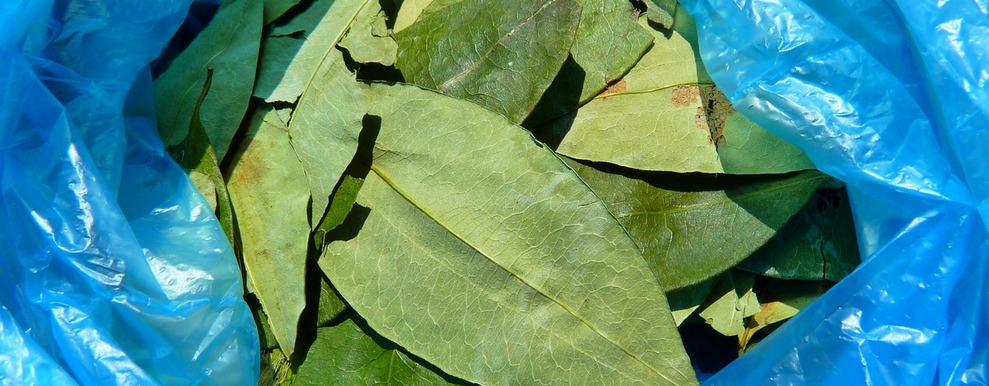
Coca (Erythroxylum coca)
The genus Erythroxylum includes approximately 230 species, with two species – Erythroxylum coca Lam. and Erythroxylum novogranatense, are particularly important and have been cultivated by traditional South American civilizations for generations. It is a small tree or shrub, growing to a height of 2-3 meters, which is endemic in the Andean-Amazon region in today’s territory of the states of Colombia, Bolivia, Ecuador and Peru. It needs a warm and humid climate of tropical regions, sufficient sunlight and an altitude between 500-2000 meters above sea level.
In South America, coca is one of the oldest cultivated plant species with evidence of its use dating back to 3000 BC. Its consumption remains a part of traditional medicine in many Andean and Amazonian communities and is used to relieve toothache, muscle and joint pain, indigestion, to suppress hunger and to overcome conditions associated with altitude differences (the Andean-Amazonian region is located at high altitude).
Coca leaves contain, among other phytochemical components, the highest amount of the tropane alkaloid benzoyl methylecgonine, known as cocaine (about 0.1-0.9% by weight), which was first isolated from the plant in 1855. The direct effect of cocaine is manifested at a lower concentration in the blood with increased libido, a feeling of energy and sexual excitement. A higher concentration of cocaine in the blood results in a feeling of incredible euphoria and energy. At the same time in both cases, i.e. lower and higher concentration in the blood, it is associated with the suppression of fatigue, an increase in self-confidence, a feeling of increased physical strength, aggressiveness and other effects.
Currently, cocaine is the world’s second most abused drug, with an estimated annual production of 1,980 tons (year 2020). Due to the endemic occurrence of the coca plant, it is in the truest sense a “Drug cash crop”, as it is purposefully grown, processed and the resulting product – cocaine, illegally distributed throughout the world. Massive environmental damage is also associated with this. On the one hand, in the form of cutting down rainforests and the destruction of the natural ecosystem, which is then replaced only by coca, and on the other hand, its transport (ships, planes, trucks), which leaves behind a significant carbon footprint. To give you an idea, in 2020 alone, an estimated 234,200 hectares of rainforest were cut down to grow coca (that’s about 328,000 football fields). However, the most tragic environmental impacts result from the chemicals used to make cocaine. The production of 100 kg of cocaine hydrochloride requires 100–300 liters of sulfuric acid, 20–40 liters of hydrochloric acid, 20–55 kg of potassium permanganate and 1000–2000 liters of organic solvents. The chemicals used end up in local rivers, forests and the sea.
In addition to the environmental impacts, the demand for cocaine is also linked to the activities of extremely dangerous Mexican and Colombian criminal cartels, whose activities, in addition to the production and distribution of addictive substances, are characterized by murder, kidnapping, extortion, corruption and terrorism. Long-term (chronic) narcotic abuse of cocaine is associated with a whole range of serious health problems caused by its cardiotoxicity and neurotoxicity. Cocaine exhibits multi-organ toxicity in its effect on the body, and many of these effects are caused by increased stimulation of the adrenergic system. The most significant toxic effects include cardiotoxicity, because in acute intoxication it leads to an increase in blood pressure and heart rate, thereby increasing the demands of the heart muscle for oxygen consumption. It is also significantly involved in the development of atherosclerosis of the arteries, thereby increasing the risk of acute myocardial infarction. Another possible side effect, especially with long-term use, is the increased risk of developing a number of psychopathologies, such as mood disorders, personality disorders or psychosis. Last but not least, it is characterized by a high risk of addiction. The lethal dose for humans is around 1.2 grams.
However, cocaine has its place in modern medicine, where it has found its legal, albeit limited, use mainly as a local anesthetic during minor surgical procedures on the nose, throat or pharynx.
On average, 1 g of cocaine is sold for CZK 2,000 in the Czech Republic. On the dance floor, in nightclubs and bars, its price can be even higher.
Sources:
- doi: 10.1155/2016/4048764
- doi: 10.1016/j.disamonth.2008.10.002
- doi.org/10.3390/molecules24203788
- UNODC, World Drug Report 2022 (United Nations publication, 2022)
- dx.doi.org/10.37355/fvpk-2022/2-01
- 10.3390/molecules24040796
- 10.1159/000140625
- 10.2165/00002018-199309030-00006

